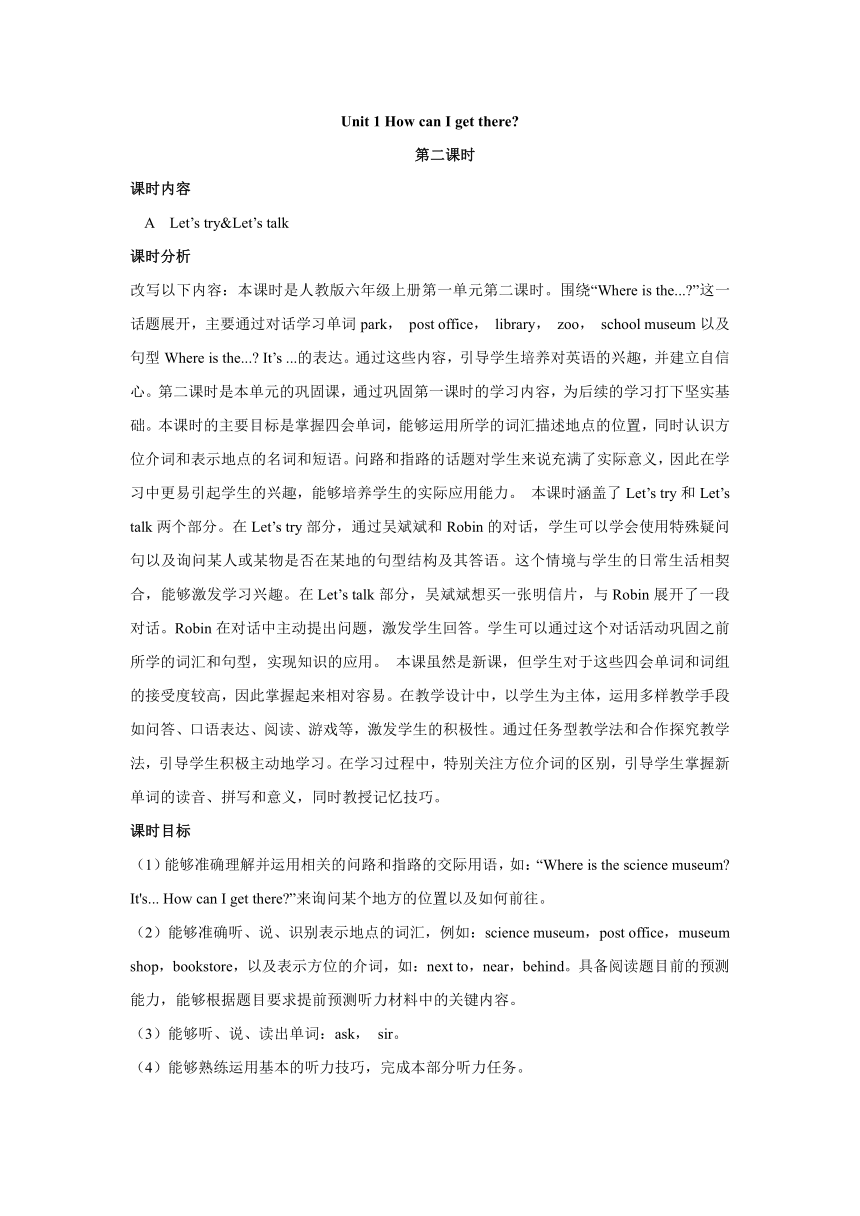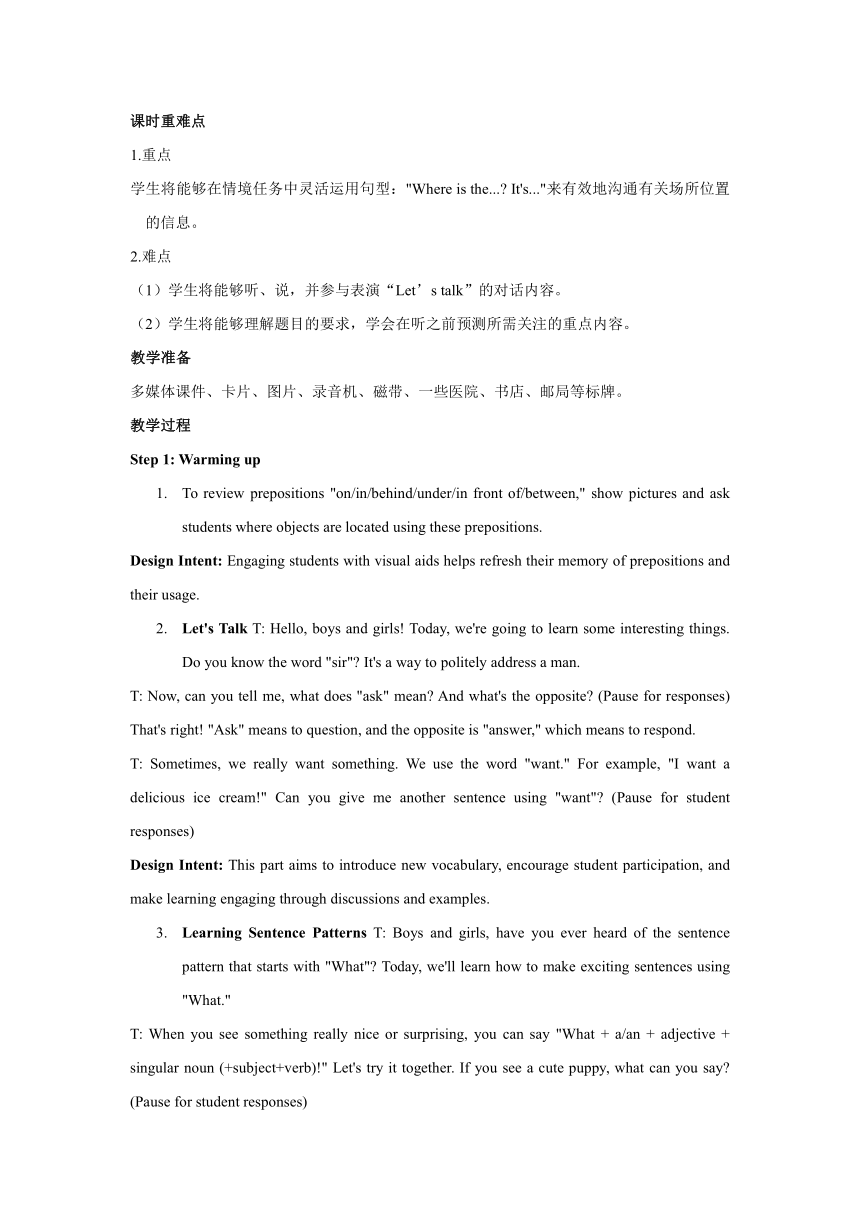Unit 1 How can I get there Part A Let’s try Let’s talk 教学设计
文档属性
| 名称 | Unit 1 How can I get there Part A Let’s try Let’s talk 教学设计 |  | |
| 格式 | docx | ||
| 文件大小 | 21.7KB | ||
| 资源类型 | 教案 | ||
| 版本资源 | 人教版(PEP) | ||
| 科目 | 英语 | ||
| 更新时间 | 2023-08-23 17:38:32 | ||
图片预览


文档简介
Unit 1 How can I get there
第二课时
课时内容
A Let’s try&Let’s talk
课时分析
改写以下内容:本课时是人教版六年级上册第一单元第二课时。围绕“Where is the... ”这一话题展开,主要通过对话学习单词park, post office, library, zoo, school museum以及句型Where is the... It’s ...的表达。通过这些内容,引导学生培养对英语的兴趣,并建立自信心。第二课时是本单元的巩固课,通过巩固第一课时的学习内容,为后续的学习打下坚实基础。本课时的主要目标是掌握四会单词,能够运用所学的词汇描述地点的位置,同时认识方位介词和表示地点的名词和短语。问路和指路的话题对学生来说充满了实际意义,因此在学习中更易引起学生的兴趣,能够培养学生的实际应用能力。 本课时涵盖了Let’s try和Let’s talk两个部分。在Let’s try部分,通过吴斌斌和Robin的对话,学生可以学会使用特殊疑问句以及询问某人或某物是否在某地的句型结构及其答语。这个情境与学生的日常生活相契合,能够激发学习兴趣。在Let’s talk部分,吴斌斌想买一张明信片,与Robin展开了一段对话。Robin在对话中主动提出问题,激发学生回答。学生可以通过这个对话活动巩固之前所学的词汇和句型,实现知识的应用。 本课虽然是新课,但学生对于这些四会单词和词组的接受度较高,因此掌握起来相对容易。在教学设计中,以学生为主体,运用多样教学手段如问答、口语表达、阅读、游戏等,激发学生的积极性。通过任务型教学法和合作探究教学法,引导学生积极主动地学习。在学习过程中,特别关注方位介词的区别,引导学生掌握新单词的读音、拼写和意义,同时教授记忆技巧。
课时目标
(1)能够准确理解并运用相关的问路和指路的交际用语,如:“Where is the science museum It's... How can I get there ”来询问某个地方的位置以及如何前往。
(2)能够准确听、说、识别表示地点的词汇,例如:science museum,post office,museum shop,bookstore,以及表示方位的介词,如:next to,near,behind。具备阅读题目前的预测能力,能够根据题目要求提前预测听力材料中的关键内容。
(3)能够听、说、读出单词:ask, sir。
(4)能够熟练运用基本的听力技巧,完成本部分听力任务。
课时重难点
1.重点
学生将能够在情境任务中灵活运用句型:"Where is the... It's..."来有效地沟通有关场所位置的信息。
2.难点
(1)学生将能够听、说,并参与表演“Let’s talk”的对话内容。
(2)学生将能够理解题目的要求,学会在听之前预测所需关注的重点内容。
教学准备
多媒体课件、卡片、图片、录音机、磁带、一些医院、书店、邮局等标牌。
教学过程
Step 1: Warming up
To review prepositions "on/in/behind/under/in front of/between," show pictures and ask students where objects are located using these prepositions.
Design Intent: Engaging students with visual aids helps refresh their memory of prepositions and their usage.
Let's Talk T: Hello, boys and girls! Today, we're going to learn some interesting things. Do you know the word "sir" It's a way to politely address a man.
T: Now, can you tell me, what does "ask" mean And what's the opposite (Pause for responses) That's right! "Ask" means to question, and the opposite is "answer," which means to respond.
T: Sometimes, we really want something. We use the word "want." For example, "I want a delicious ice cream!" Can you give me another sentence using "want" (Pause for student responses)
Design Intent: This part aims to introduce new vocabulary, encourage student participation, and make learning engaging through discussions and examples.
Learning Sentence Patterns T: Boys and girls, have you ever heard of the sentence pattern that starts with "What" Today, we'll learn how to make exciting sentences using "What."
T: When you see something really nice or surprising, you can say "What + a/an + adjective + singular noun (+subject+verb)!" Let's try it together. If you see a cute puppy, what can you say (Pause for student responses)
T: Great! Now, when you see more than one thing, or something you can't count, you can say "What + adjective + plural/uncountable noun (+subject+verb)!" Can you give me an example (Pause for student responses)
Design Intent: Teaching sentence patterns in an interactive manner helps students grasp grammar concepts more effectively and encourages them to construct their own sentences using the newly learned patterns.
Step 2: Presentation
Let's Talk (1) T: Look at this picture, everyone. Can you tell me, "What place is it " Discuss with your group and share your ideas.
(2) T: Now, each group, please show us your answers. Who would like to share first
(3) T: Let's listen to a recording and practice how to say these sentences. Listen carefully and repeat after me.
(4) T: Now, I want [Student's Name] to read this sentence. Can you also tell us what it means in Chinese
Design Intent: This sequence promotes collaborative learning, listening practice, and pronunciation practice in a dynamic and engaging manner.
Let's Say (1) T: Are you ready for a fun game I'm going to show you a map. I will ask you where different places are. For example, "Where is the science museum " Who can tell me where it is
(2) T: Great job! Now, let's find the museum shop together. Is it over there (Point to different places on the map) Is it next to the library Is it behind the school Listen carefully to the recording and see if you are right.
(3) T: Now, let's imagine you're visiting the park. Where's Grandpa Listen and repeat after me.
Let's Talk Listen to a recording and get a basic understanding of the sentence pattern: "Where is the… It's near (next to)…"
Let's Try Listen to the recording and complete the "Let's try" activity.
Make a Survey T: Now, let's work in groups. We're going to do a survey about different places in our city, like museums, schools, bookstores, and post offices. Discuss where these places are located in your city. Then, each group will share their findings with the class.
Design Intent: This step gradually reinforces the new sentence pattern, engages students in a game, and encourages them to apply their knowledge to real-life situations through a survey activity.
Step3 Practice
"Little Designers" Activity T: Boys and girls, are you ready to become little designers Today, your task is to design a city map with different places on it. We have the library, post office, hospital, science museum, cinema, and bookstore. After you design your map, guess what We'll have some special guests, reporters, who will come to interview you! So, let's use your word cards and design your amazing city plans. Remember, you are the designers, and the reporters will ask you questions like "Where is the hospital " Can you answer confidently
Word Race Among Teams T: Let's have some friendly competition now! I'll divide the class into groups of six. One student will perform an action, and the other five students need to quickly say the correct word that matches the action. For example, if the action is reading a book, the word is "bookstore." Let's see which team can do it fast and accurately. Ready Go!
Design Intent: These activities involve hands-on learning, teamwork, and friendly competition, making the practice engaging and memorable for the students. The "Little Designers" activity integrates creativity, role-play, and critical thinking, while the "Word Race Among Teams" activity promotes quick recall and active participation.
Step4 Summary
T: Great job, everyone! Let's summarize what we've learned today.
Spelling Practice Today, we practiced spelling words like "ask" and "sir." Make sure you can write these words correctly.
Asking and Giving Directions We also learned how to ask and give directions using sentences like "Where is the science museum It's…" These are important phrases for asking where a place is and how to get there.
设计意图: 通过简明扼要地总结学过的单词和句型,巩固学生的学习成果。同时,着重强调交际用语的实际应用,让学生在实际情境中能够灵活运用所学知识。
板书设计
Unit 1 How can I get there
Where is the...
It’s over there./ next to/ near/ behind... .
第二课时
课时内容
A Let’s try&Let’s talk
课时分析
改写以下内容:本课时是人教版六年级上册第一单元第二课时。围绕“Where is the... ”这一话题展开,主要通过对话学习单词park, post office, library, zoo, school museum以及句型Where is the... It’s ...的表达。通过这些内容,引导学生培养对英语的兴趣,并建立自信心。第二课时是本单元的巩固课,通过巩固第一课时的学习内容,为后续的学习打下坚实基础。本课时的主要目标是掌握四会单词,能够运用所学的词汇描述地点的位置,同时认识方位介词和表示地点的名词和短语。问路和指路的话题对学生来说充满了实际意义,因此在学习中更易引起学生的兴趣,能够培养学生的实际应用能力。 本课时涵盖了Let’s try和Let’s talk两个部分。在Let’s try部分,通过吴斌斌和Robin的对话,学生可以学会使用特殊疑问句以及询问某人或某物是否在某地的句型结构及其答语。这个情境与学生的日常生活相契合,能够激发学习兴趣。在Let’s talk部分,吴斌斌想买一张明信片,与Robin展开了一段对话。Robin在对话中主动提出问题,激发学生回答。学生可以通过这个对话活动巩固之前所学的词汇和句型,实现知识的应用。 本课虽然是新课,但学生对于这些四会单词和词组的接受度较高,因此掌握起来相对容易。在教学设计中,以学生为主体,运用多样教学手段如问答、口语表达、阅读、游戏等,激发学生的积极性。通过任务型教学法和合作探究教学法,引导学生积极主动地学习。在学习过程中,特别关注方位介词的区别,引导学生掌握新单词的读音、拼写和意义,同时教授记忆技巧。
课时目标
(1)能够准确理解并运用相关的问路和指路的交际用语,如:“Where is the science museum It's... How can I get there ”来询问某个地方的位置以及如何前往。
(2)能够准确听、说、识别表示地点的词汇,例如:science museum,post office,museum shop,bookstore,以及表示方位的介词,如:next to,near,behind。具备阅读题目前的预测能力,能够根据题目要求提前预测听力材料中的关键内容。
(3)能够听、说、读出单词:ask, sir。
(4)能够熟练运用基本的听力技巧,完成本部分听力任务。
课时重难点
1.重点
学生将能够在情境任务中灵活运用句型:"Where is the... It's..."来有效地沟通有关场所位置的信息。
2.难点
(1)学生将能够听、说,并参与表演“Let’s talk”的对话内容。
(2)学生将能够理解题目的要求,学会在听之前预测所需关注的重点内容。
教学准备
多媒体课件、卡片、图片、录音机、磁带、一些医院、书店、邮局等标牌。
教学过程
Step 1: Warming up
To review prepositions "on/in/behind/under/in front of/between," show pictures and ask students where objects are located using these prepositions.
Design Intent: Engaging students with visual aids helps refresh their memory of prepositions and their usage.
Let's Talk T: Hello, boys and girls! Today, we're going to learn some interesting things. Do you know the word "sir" It's a way to politely address a man.
T: Now, can you tell me, what does "ask" mean And what's the opposite (Pause for responses) That's right! "Ask" means to question, and the opposite is "answer," which means to respond.
T: Sometimes, we really want something. We use the word "want." For example, "I want a delicious ice cream!" Can you give me another sentence using "want" (Pause for student responses)
Design Intent: This part aims to introduce new vocabulary, encourage student participation, and make learning engaging through discussions and examples.
Learning Sentence Patterns T: Boys and girls, have you ever heard of the sentence pattern that starts with "What" Today, we'll learn how to make exciting sentences using "What."
T: When you see something really nice or surprising, you can say "What + a/an + adjective + singular noun (+subject+verb)!" Let's try it together. If you see a cute puppy, what can you say (Pause for student responses)
T: Great! Now, when you see more than one thing, or something you can't count, you can say "What + adjective + plural/uncountable noun (+subject+verb)!" Can you give me an example (Pause for student responses)
Design Intent: Teaching sentence patterns in an interactive manner helps students grasp grammar concepts more effectively and encourages them to construct their own sentences using the newly learned patterns.
Step 2: Presentation
Let's Talk (1) T: Look at this picture, everyone. Can you tell me, "What place is it " Discuss with your group and share your ideas.
(2) T: Now, each group, please show us your answers. Who would like to share first
(3) T: Let's listen to a recording and practice how to say these sentences. Listen carefully and repeat after me.
(4) T: Now, I want [Student's Name] to read this sentence. Can you also tell us what it means in Chinese
Design Intent: This sequence promotes collaborative learning, listening practice, and pronunciation practice in a dynamic and engaging manner.
Let's Say (1) T: Are you ready for a fun game I'm going to show you a map. I will ask you where different places are. For example, "Where is the science museum " Who can tell me where it is
(2) T: Great job! Now, let's find the museum shop together. Is it over there (Point to different places on the map) Is it next to the library Is it behind the school Listen carefully to the recording and see if you are right.
(3) T: Now, let's imagine you're visiting the park. Where's Grandpa Listen and repeat after me.
Let's Talk Listen to a recording and get a basic understanding of the sentence pattern: "Where is the… It's near (next to)…"
Let's Try Listen to the recording and complete the "Let's try" activity.
Make a Survey T: Now, let's work in groups. We're going to do a survey about different places in our city, like museums, schools, bookstores, and post offices. Discuss where these places are located in your city. Then, each group will share their findings with the class.
Design Intent: This step gradually reinforces the new sentence pattern, engages students in a game, and encourages them to apply their knowledge to real-life situations through a survey activity.
Step3 Practice
"Little Designers" Activity T: Boys and girls, are you ready to become little designers Today, your task is to design a city map with different places on it. We have the library, post office, hospital, science museum, cinema, and bookstore. After you design your map, guess what We'll have some special guests, reporters, who will come to interview you! So, let's use your word cards and design your amazing city plans. Remember, you are the designers, and the reporters will ask you questions like "Where is the hospital " Can you answer confidently
Word Race Among Teams T: Let's have some friendly competition now! I'll divide the class into groups of six. One student will perform an action, and the other five students need to quickly say the correct word that matches the action. For example, if the action is reading a book, the word is "bookstore." Let's see which team can do it fast and accurately. Ready Go!
Design Intent: These activities involve hands-on learning, teamwork, and friendly competition, making the practice engaging and memorable for the students. The "Little Designers" activity integrates creativity, role-play, and critical thinking, while the "Word Race Among Teams" activity promotes quick recall and active participation.
Step4 Summary
T: Great job, everyone! Let's summarize what we've learned today.
Spelling Practice Today, we practiced spelling words like "ask" and "sir." Make sure you can write these words correctly.
Asking and Giving Directions We also learned how to ask and give directions using sentences like "Where is the science museum It's…" These are important phrases for asking where a place is and how to get there.
设计意图: 通过简明扼要地总结学过的单词和句型,巩固学生的学习成果。同时,着重强调交际用语的实际应用,让学生在实际情境中能够灵活运用所学知识。
板书设计
Unit 1 How can I get there
Where is the...
It’s over there./ next to/ near/ behind... .
同课章节目录
